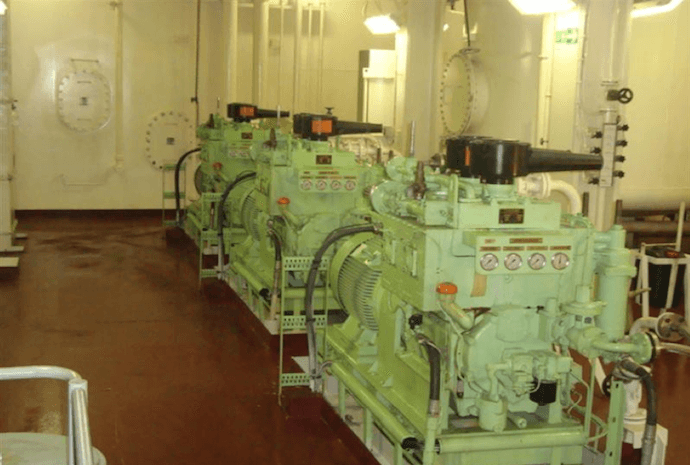

Every Air compressor on a ship is fitted with several safety features to avoid abnormal and dangerous operational errors of the equipment. If safety, alarms and trips are not present on the air compressor, abnormal operation may lead to breakdown of the compressor and may also injure a person working on or around it.
Different safety features on an air compressor are
Relief valve:
Fitted after every stage to release excess pressure developed inside it. The setting of the lifting pressure increases after every ascending stage. Normally fitted between 1st stage and intercooler and 2nd stage – aftercooler.


Bursting disc:
A bursting disc is a copper disc provided at the air cooler of the compressor. It is a safety disc which bursts when the pressure exceeds over the pre-determined value due to leaky air tubes of the cooler (intercooler or aftercooler).
Fusible plug:
Generally located on the discharge side of the compressor, it fuses if the air temperature is higher than the operational temperature. The fusible plug is made up of material which melts at high temperature.
Lube Oil low pressure alarm and trip:
If the lube oil pressure goes lower than the normal, the alarm is sounded followed by a cut out trip signal to avoid damage to bearings and crank shaft.
Water high temperature trip:
If the intercoolers are choked or the flow of water is less, then the air compressor will get over heated. To avoid this situation high water temperature trip is activated which cut offs the compressor.
Water no-flow trip:
If the attached pump is not working or the flow of water inside the intercooler is not enough to cool the compressor then moving part inside the compressor will get seized due to overheating. A no flow trip is provided which continuously monitor the flow of water and trips the compressor when there is none.
Motor Overload trip:
If the current taken by motor during running or starting is very high then there is a possibility of damage to the motor. An overload trip is thus fitted to avoid such situation.
Maintenance
A compressor requires a proper planned routine maintenance for safe and efficient operation and to avoid breakdown maintenance. Routine for maintenance depends on the manufacturer’s advice given in the manual. The following are the maintenance checks that should be carried out after the mentioned running hours.
@ 250hrs:
1) Clean air filter.
2) Check un-loader operation.
3) If belt is provided for driving cooling water pump, check its tightness.
@ 500hrs:
1) Change lube oil and clean sump.
2) Clean lube oil filter.
3) Check and renew suction and discharge valves with overhauled one.
@ 1000 hrs:
1) Crankcase inspection, main and big end bearing inspection.
2) Relief valve overhauling.
@ 4000 hrs:
1) Piston and big end bearing overhauling, piston ring renewal.
2) Intercooler cleaning.
3) Motor overhauling.
Running hour may differ from maker to maker. The above description is a rough idea for a general maintenance of marine air compressor.
Without the supply of air, a ship will soon be termed as a dead ship. It is very important for a marine engineer to understand the importance of the compressor; hence it’s the responsibility of the engineer onboard to maintain the compressor, the air receiver and the air pipe line and the overall system in the proper condition.
You may also like to read – Compressed Air Line On Ships – A General Overview










We believe that knowledge is power, and we’re committed to empowering our readers with the information and resources they need to succeed in the merchant navy industry.
Whether you’re looking for advice on career planning, news and analysis, or just want to connect with other aspiring merchant navy applicants, The Marine Learners is the place to be.